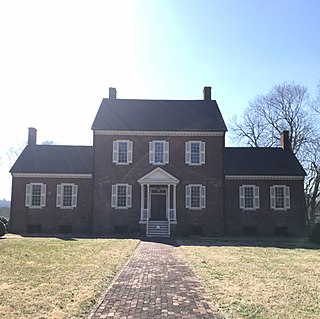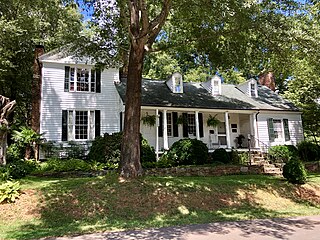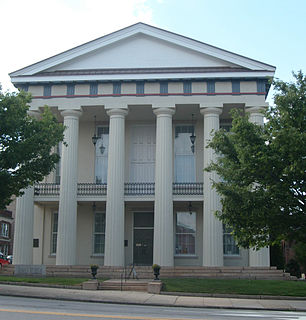
The town of Hillsborough is the county seat of Orange County, North Carolina and is located along the Eno River. The population was 6,087 in 2010.
Francis Nash was a brigadier general in the Continental Army during the American Revolutionary War. Prior to the war, he was a lawyer, public official, and politician in Hillsborough, North Carolina, and was heavily involved in opposing the Regulator movement, an uprising of settlers in the North Carolina piedmont between 1765 and 1771. Nash was also involved in North Carolina politics, representing Hillsborough on several occasions in the colonial North Carolina General Assembly.

William Alexander Graham was a United States Senator from North Carolina from 1840 to 1843, a Senator later in the Confederate States Senate from 1864 to 1865, the 30th Governor of North Carolina from 1845 to 1849 and U.S. Secretary of the Navy from 1850 to 1852, under President Millard Fillmore. He was the Whig Party nominee for vice-president in 1852 on a ticket with General Winfield Scott.

Ayr Mount is a Federal style plantation house located east of Hillsborough, in Orange County, North Carolina, the United States of America.

The Chowan County Courthouse is a historic courthouse in Edenton, the county seat of Chowan County, North Carolina. Built in 1767, it is one of the finest examples of public Georgian architecture in the American South. It was declared a National Historic Landmark in 1970.

The Nash-Hooper House, also known as the William Hooper House, is a historic house at 118 West Tryon Street in Hillsborough, North Carolina. Built in 1772 by American Revolutionary War general Francis Nash, it was home from 1782-90 to William Hooper, a signer of the United States Declaration of Independence. It is the only known home of Hooper's to survive, and was declared a National Historic Landmark in 1971. It is located in the Hillsborough Historic District; it is a private residence, and is not normally open to the public.

Camden County Courthouse is a historic county courthouse in Camden, an unincorporated area in Camden County, North Carolina, USA. The courthouse was built in 1847; it is a single-storey brick building in the Greek Revival style. It features a pedimented porch and large windows.

Hillsborough Historic District is a national historic district located at Hillsborough, Orange County, North Carolina. The district encompasses 529 contributing buildings, 9 contributing sites, 13 contributing structures, and 2 contributing objects in the central business district and surrounding residential sections of Hillsborough. The district includes buildings dating to the late-18th and early-20th century and includes notable examples of Federal, Greek Revival, and Italianate style architecture. Located in the district are the separately listed Burwell School, Eagle Lodge, Hazel-Nash House, Heartsease, Montrose, Nash Law Office, Nash-Hooper House, Old Orange County Courthouse, Ruffin-Roulhac House, Sans Souci, and St. Matthew's Episcopal Church and Churchyard. Other notable buildings include Seven Hearths, the Presbyterian Church (1815-1816), Methodist Church (1859-1860), First Baptist Church (1862-1870), Twin Chimneys, and the Berry Brick House.

St. Matthew's Episcopal Church and Churchyard is a historic Episcopal church located on St. Mary's Road, Hillsborough, Orange County, North Carolina. The first three bays of the Gothic Revival-style brick church were built between 1825–1826, and its rear was extended by another bay in 1868. It features a square entrance tower built in 1830, which was rebuilt in 1850. The tower has a pyramidal spire and lancet windows.

The Columbus County Courthouse is a historic courthouse building located at Whiteville, Columbus County, North Carolina. The two-story Classical Revival style building was designed by Joseph F. Leitner's firm, and built in 1914–1915. It is a rectangular brick and concrete building and features a pedimented, tetrastyle Doric order portico.

The Old Davidson County Courthouse is a historic courthouse building located at Lexington, Davidson County, North Carolina. It was built in 1858, and is a two-story, gable front stuccoed stone temple-form building. It features a prostyle hexastyle portico, with fluted Roman Corinthian order columns. Above the portico is an octagonal clock tower. It was remodeled in 1918. Most county offices moved to a new courthouse built in 1959.

Caswell County Courthouse is a historic county courthouse located at Yanceyville, Caswell County, North Carolina. It was built between 1858 and 1861, and is a rectangular two-story, stuccoed brick building, five bays wide and seven deep. It sits on an elevated granite block foundation and features a two-level recessed entrance porch and octagonal cupola.

Sans Souci is a historic home located at Hillsborough, Orange County, North Carolina. It was built about 1813, as two-story, three bay, frame dwelling with a gable roof and set on a brick foundation. Later additions included 1 1/2-story flanking wings added in the Federal period and a Greek Revival shed addition built in the mid-19th century across the rear of the main block and the east wing. Also on the property are the contributing kitchen, office, and servant's quarters.

Hazel-Nash House, also known as the Hasell-Nash House, is a historic home located at Hillsborough, Orange County, North Carolina. It was built about 1820, and consists of a two-story, three bay, pedimented central block flanked by a pair of pedimented single-story wings. The front facade features a single-story porch supported by Ionic order columns and a central Palladian window. Its design is probably based on Robert Morris (1703–1754) plate 37 of his Rural Architecture..

Heartsease is a historic home located at Hillsborough, Orange County, North Carolina. It was built about 1770, and consists of a 1 1/2-story, three-bay, central block dating to the late 18th century, with an early 19th-century 1 1/2-story east wing, and two-story pedimented west wing added in the late 19th century. It is topped by a gable roof and features a shed porch whose roof supported by plain Tuscan order posts. It is believed that Heartsease served as the pre-Revolutionary home of Thomas Burke, North Carolina's third governor and a member of the Constitutional Convention.

Ruffin-Roulhac House, also known as Little Hawfields, is a historic home located at Hillsborough, Orange County, North Carolina. It was built about 1820, and is a 1 1/2-story, five bay, frame dwelling including a two-room addition built about 1830. It is topped by a gable roof, is sheathed in weatherboard, and has a one-bay 20th century replacement porch. The interior has Federal, Greek Revival, and Victorian style design elements. It was the home of jurist Thomas Ruffin (1787–1870) from after the end of the American Civil War until his death in 1870.

Moorefields is a historic plantation home located near Hillsborough, Orange County, North Carolina. It was built about 1785, and consists of a two-story central block, three bays wide, with flanking one-bay wings in the Federal style. The house features a shed porch with turned wooden posts. It was built by soldier and judge Alfred Moore (1755-1810).

Eagle Lodge is a historic Masonic lodge building located at Hillsborough, Orange County, North Carolina. It was built in 1823, and two-story, three bay, square brick building in the Greek Revival style. It has a low hipped roof with heavy box cornice and a one-story pedimented porch with Ionic order columns.

Nash Law Office is a historic office building located at Hillsborough, Orange County, North Carolina. It was built in 1801, and is a small one-story, frame building with a gable roof and low brick foundation. It has a brick exterior end chimney and a small one-story wing added in 1865. The building housed the law office of jurist Frederick Nash (1781-1858). Following his death it housed a school and was purchased by the Hillsborough Historical Society in 1970.

The Community Building, originally built as the Rowan County Courthouse, is a historic building located at Salisbury, Rowan County, North Carolina. It was built between 1854 and 1857, and is a two-story, Classical Revival, stuccoed brick building on a granite foundation. It measures 50 feet wide and 85 feet long and features a pedimented portico supported by six Doric order columns. The portico includes a cast iron balcony and the building is distinguished by tall windows. A new Rowan County Courthouse was built in 1914, and the building used as a community center. The building is operated by the Rowan Museum.
























